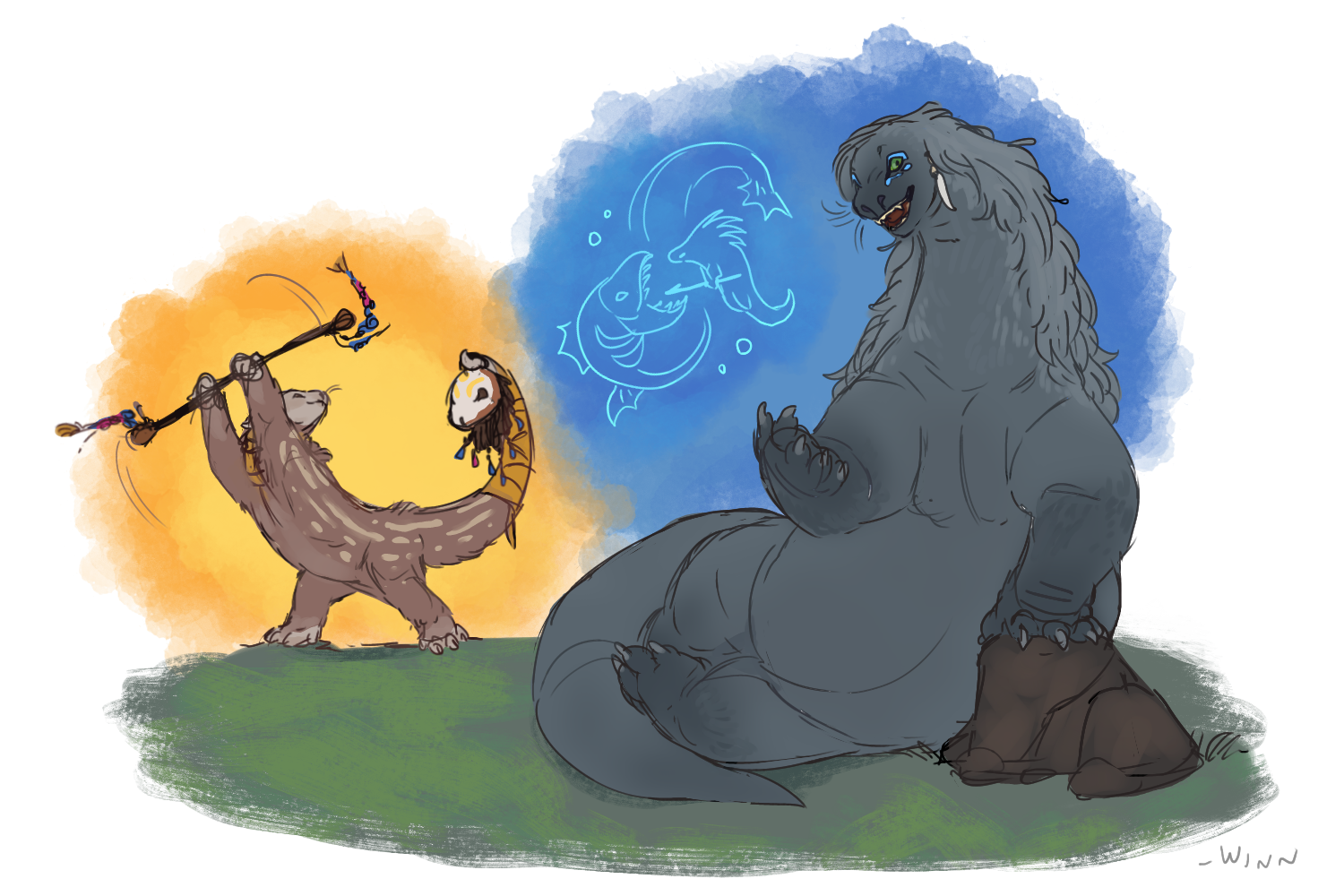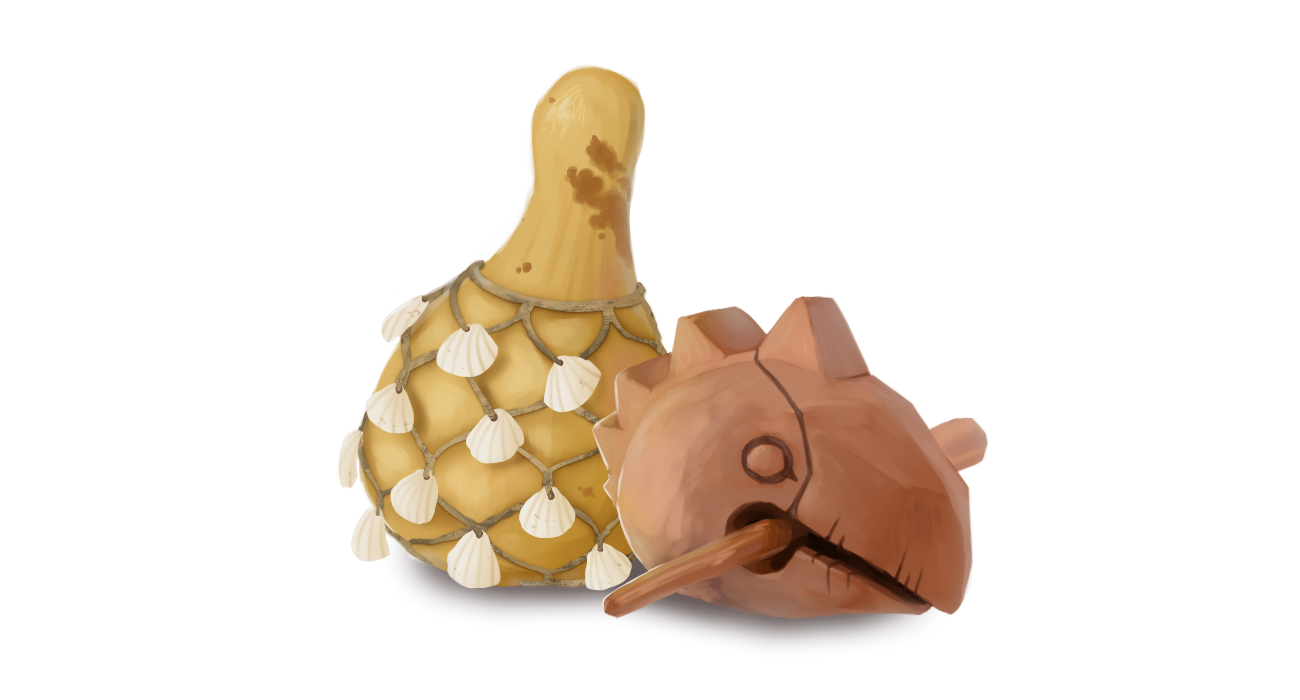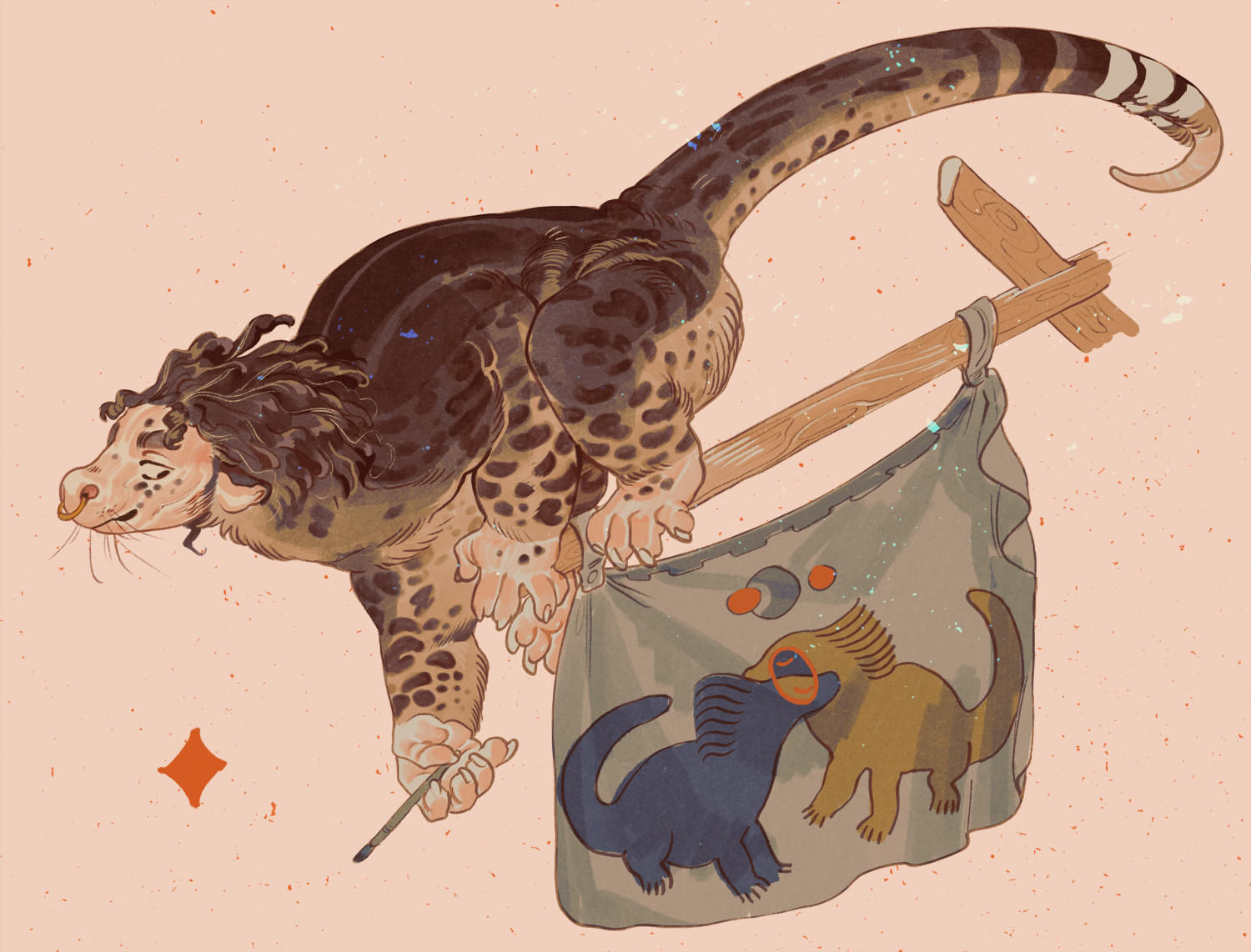The Arts
With so many clans and cultures rubbing shoulders, artistic expression is as varied as you can imagine. From lissa songs and water dances, to kipsang puppetry and written word, shared crafts and traded techniques, the full breadth of the arts can hardly be covered in its entirety. This page will detail broad strokes and points of interest.
Performance, Dance, Storytelling, and Acting
Flowing from generation to generation, nested in hearts and held waiting to spring forth, stories are the lifeblood of any people. There are many ways in which stories are told across Arra.
Foundational is the art of spoken words. Simple, convincing language is enough to evoke thoughts of brave heroes and grave misfortunes. With just one's tongue, an audience can be taken on an adventure that breathes, flutters, and even quickens the blood.
Further this with visual embellishments, or music, and you have a performance that will catch attention by the scruff. Additions such as makeup or props, or actors playing out a rendition of scenes, serve to elevate a tale from interesting to captivating. Though, many still prefer the simplicity of telling a story plainly.
Lissa have been using their voices to chronicle history and myth for thousands of years. Oral storytelling has been a vital key to preserving and communicating what has come before. Kipsang, conversely, have made use of pictures to convey meaning alongside, or even in place of speech, for equally as long.
It is no surprise then, that throughout the many points of cultural contact and exchange, clans of all kinds have found ways to bridge the two ancient throughlines of storytelling.
Take for example a pair of storytellers, one a lissa, orating, the other a kipsang, playing the protagonist of the tale. Let's say the lissa comes from a cultural background wherein stories keep to a beat, and thus has a drum handy to pound out a steady rhythm to. The kipsang, meanwhile, hailing from a clan that embellishes costume with bells and clacking ornaments, adds to the soundscape with each movement. Together they tell the story of a warrior challenging many dangerous beasts, and their joined efforts paint a thrilling atmosphere!
One's own body is a wonderful tool in any performer's arsenal. To dance is to show off the dedication to train and coordinate movements in a meaningful way. To punctuate music, to express memories and ideas in a physically engaging practice.
Costumes, accessories, worn instruments, rods... dancers utilize many things to color their performances and draw the eye. Some elements are more visual, such as streamers, tassels, flags, cloth, masks, paint, and feathers, while others produce all manner of sounds when jostled or struck in order to tickle the senses of the audience.
While dances and all related ornamentations are used frequently in storytelling, as explained above, dance is a strong artform in its own right.

A kipsang performer playing the role of a two-headed hero, and a lissa storyteller reocounting an underwater epic. (By Winn)
Music
Music is a beast of many forms. Depending on the performer, it could range anywhere from strictly vocal to a highly complex percussive rhythm. It might be best to start with instruments themselves. They are categorized thusly:
Vocal: Nearly everyone possesses the first: a voice, which makes this the most common instrument of all. Through shouts, guttural chuffs, yips and yowls, barks, whoops, humming, etc., songs can be performed entirely with one's throat, regardless of species. Though, lissa possess an extraordinary vocal stamina and powerful volume due to their anatomy.
Additionally there are forms of instrument that amplify or distort vocal expression, typically "tubes" one can vocalize into.
Percussive: Anything that required being knocked, struck, stroked, beat, shaken, rattled, or thumped to produce its intended sound is a percussive instrument. Wooden chimes are an example of a pitched percussive instrument, producing various tones, while drums are an example of a pitchless instrument.
Drums are composed of animal skins stretched over hollow "shells", often dried gourds or tuga shells. They can be struck with the forepaws, the tail, sticks...etc. to produce a resonant sound.
Rattles are handheld (or tailheld) shaker instruments with various forms. Sand filled nutshells and hollowed pits, sticks strung with seashells and stones, and more. Some rattles are even crafted from the skulls of animals.
Chimes are any pitched percussive instrument that carries a different sound depending on where they are struck. Windchimes knock against each other when blown by the wind to passively create pleasant tones, while a drumchime must be actively played by striking specific points of the instrument with sticks or, for those who can manage it, claws.
Stringed: Stringed instruments are played by strumming lengths of cord strung against a frame. String material may include woven cord, sinew, hair...etc. An old kipsang tale tells of the first stringed instrument being the inner cords of a fearsome beast, strung still warm from the animal's gut upon a sturdy length of wood.
Blown: Blown instruments are defined as being played via blowing into the body of the instrument. Some blown instruments, such as the fearwhistle and birdcaller, have their uses not as musical instruments, but practical tools. Blown instruments with a sharper slant of sound are sometimes discouraged for casual use as they can be quite loud.
Generally instruments are simple in make and play, making them fairly accessible and therefore often iterated upon through various cultural channels.
As for music itself, many styles of it have found their way into the greater world. From the hearty, percussive work-chants of clan Frost In The Whiskers, to the quick and liquid melodies of clan Sluiced Heart. Ballads, poems and stories sung for performances often wriggle their way into the idle hummings of their audiences, longafter the last note fades from the stage, and thus they spread further still.

A hollow gourd rattle strung with shells and a roc shaped croaker. (By Winn)
Markmaking, Drawing, and Painting
The mind contains many visual wonders. Memories of sunlight and water, the cool of the moon's glow, the heat of steam curling up and away, the shape of a go-urra in stride--or imagined things, phantasms that flitter in all the colors of the world. Picture-making artists (in this age of widespread trade, clan collaboration, and the growth of knowledge) have access to a wide assortment of tools with which to make forms.
There are simple methods such as scratching, dentmaking, sand, mud, and dirt drawing, and object arrangement for the purposes of creating a rudimentary picture which require little to no specialized tools.
But we can go beyond that, no? With paints, dyes, inks, pigments, pastes, and other staining or mark-making substances one can create bolder, more colorful visual creations. These materials aren't necessarily too complex to find or produce. A particularly dark berry might have juices perfect for the purposes of smearing an image onto a surface. A piece of charcoal can leave a thick, steady line in its wake. Yet, through trial and error, methods have been discovered to create materials of higher quality. One can crush ingredients with deep hues (such as red earth, flowers, or even the carapaces of insects) into a fine, dry powder, then thoroughly mix this powder with water and additionally a binding liquid, to make most paints and inks. The use of egg yolks, seed oils, and other materials for strengthening the properties of these substances has grown more popular as knowledge is passed along and added to. There are entire groups who dedicate themselves to experimenting with pigments and searching throughout Arra for new ingredients.
Surfaces for making marks upon are equally as various. Leaves, stone, textiles, skin--if it can retain a color on its surface, it will do.
As for the images these materials are used to create, there is no limit to what one can depict. Animals, places, people, history...both real and imagined, graphic and abstract. Every clan and artist therein has their own way of shaping lines and colors into comprehensible forms. Clan Watching Panther, for example, has developed means to teach various "styles" of artistic expression to those that wish to learn. Some artists want to recreate what they see as closely as one can manage, while others want to express the immediate emotion or impact of their subject in a less realistic way, or shape the outlines and contours of a subject into something more coordinated, reshaped.
The creation of images is, after all, a form of communication and even storytelling as much as spoken word. It changes as it moves from one individual to another, and changes further still.

Chicory, a kipsang artist perched atop a romantic drawing of his own creation. (By Searrach)
Carving and Sculpture
Drawing is not the only way to portray an image. Enter carving and sculpture, which transform the purely visual into something tactile and, to some, more real. Such a creation can be turned around in the hand. Stroked, prodded, gnawed upon! The experience offered by a pictorial recreation now reaches further into the realm of other senses.
Wood is a popular candidate for carving, as is stone. Clay, earth, and mud define the origins of sculpture. These two paths of creating a form with dimentionality are opposite to one another: one relying on the reduction of material, and the other, addition. Even so, they often meet somewhere. There are carvings with sculpted additions, and sculptures with carved details. Thusly they are often considered partner disciplines.
Textiles and Weaving
...WIP
Return to Culture and Technology
